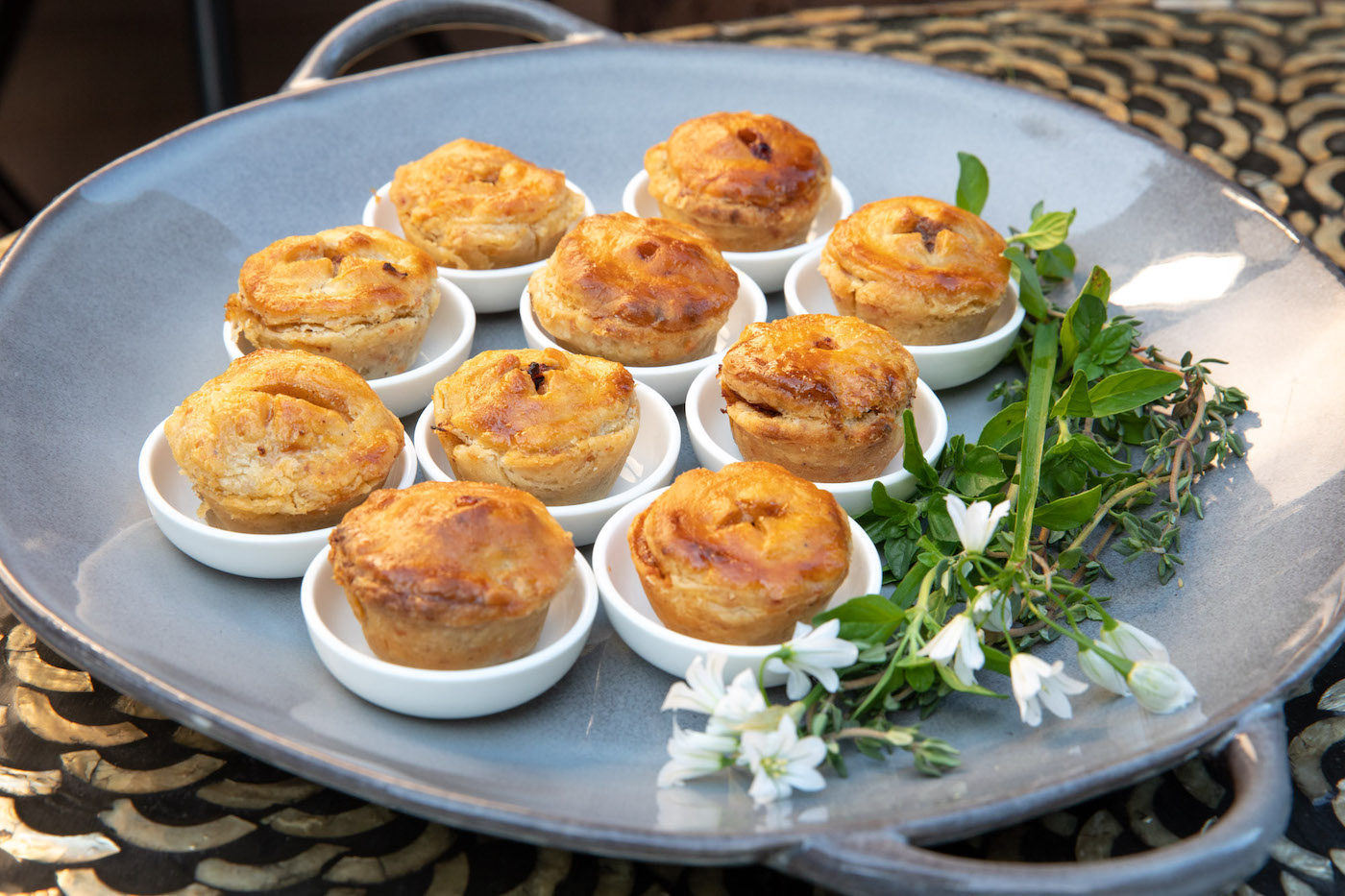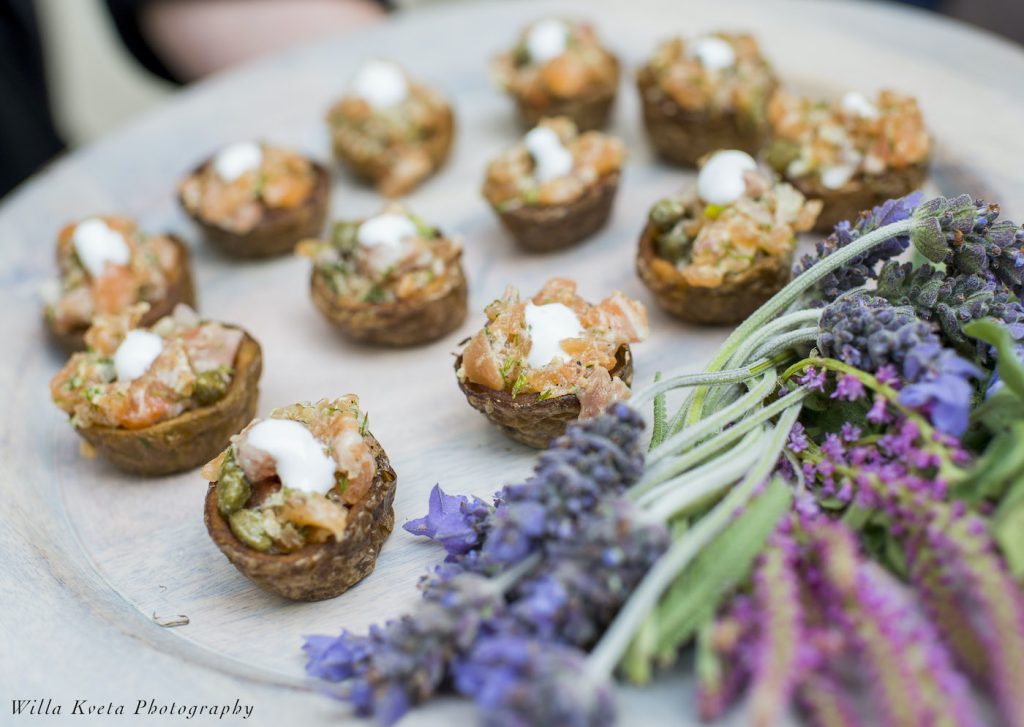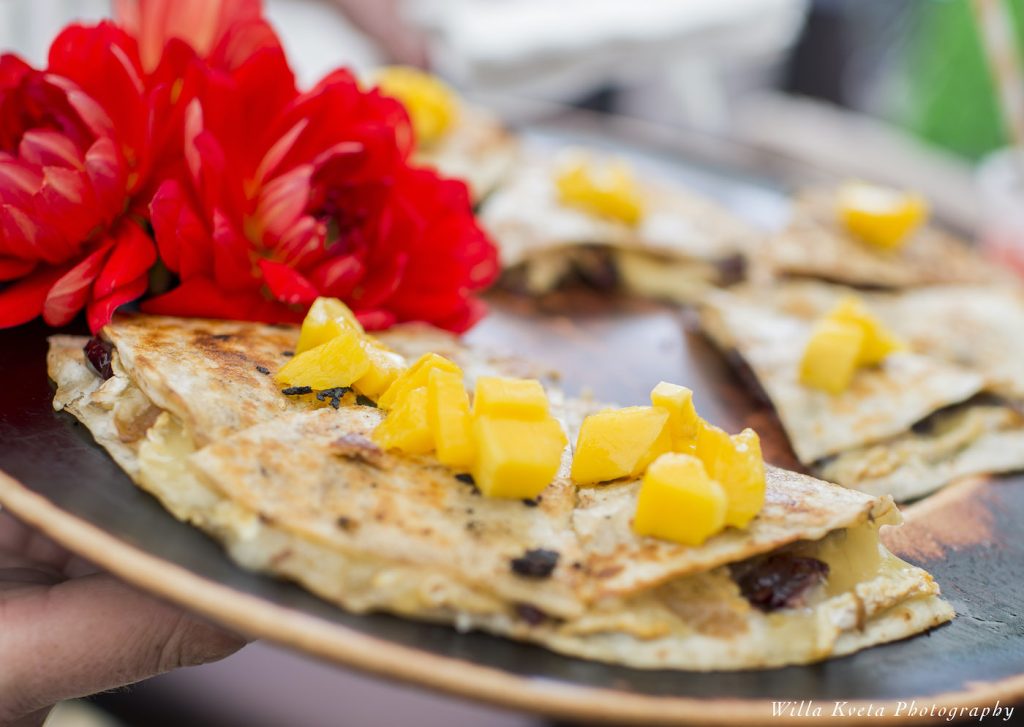Pride in Joy

This summer I did what most practical women who love to shop for fashion and dine out do when their pocketbooks grow slimmer than a Raymond Carver story: I got a second job! Feeling a bit adventurous, I applied online for a position cooking for a local company named Pure Joy Catering. To my surprise, I received an email 20 minutes later offering me kitchen duty on several event dates. I selected one and was quickly confirmed to cook at an author’s book release party in Montecito.
I’m an amateur at best, but I did earn three culinary certificates from Le Cordon Bleu, certain that my training in Savory Nibbles, Korean Barbecue, and Holiday Dessert Baking would come in handy someday. Could this be the day?
I’ve spent years in hospitality – in and outside the kitchen. So working in catering isn’t too much of a stretch. Besides, I have everything a new cook needs to survive in the culinary world: sharpened knives, an apron, almost new slip-resistant flats (buried in the back of my closet, under some boxes), and a copy of Anthony Bourdain’s Kitchen Confidential.
As far as I was concerned I had nothing to lose, except, maybe, a few fingers.
So I packed my knives (a paring knife, bread knife, and nine-inch chopper) and Le Cordon Bleu blue ribbon apron in my swanky Coach handbag, and drove up Mountain Drive to my destination, which was a beautiful Mediterranean-style home with an active vineyard and plenty of space to throw a party.
A three-car garage had been transformed into a makeshift kitchen, with a portable grill, deep fryer, front-loading storage bins and coolers, coffee and tea stations, and a table dedicated to garde manger.
The catering team was made up of former hotel culinary all-stars who joined Pure Joy when health restrictions were lifted on outdoor events. Each one had their own specialty and expertise: Dane, the team’s charismatic, adrenaline-charged captain, is a project manager whose timing and execution is impeccable; Adriana, a companionable, masterful chef who worked at Rosewood Miramar before joining the team last year; and German, a jovial yet determined line cook who previously worked at Ritz Carlton Bacara. Serving the food platters and cocktails were two delightful (and hungry) college students, Conner and Jessica.
Perhaps bringing Santa Barbara’s culinary talent together is part of Pure Joy’s business plan, and what drew Pure Joy’s owner/executive chef Lynette La Mere to a life in catering.
La Mere, I learned, sources produce from farmers markets and breads from local bakers. Her beef is grass fed, from Grass Run Farms, while poultry and seafood is supplied by Harbor Meat & Seafood. A few years ago, she purchased property in Inverness, California, boasting three beehives and 60 fruit trees, which she someday hopes to utilize for her business, her staff said.
The team huddled around the event menu that was posted on a corkboard in the center of the room. It consisted of a cheese and fruit board, a raw seafood station, tray-passed ornamental appetizers, and a few seasonal desserts.
I was assigned to the cold dishes. A large amount of raw food and herbs were stored in a cooler for mise-en-place. Adriana showed me which items to assemble first, beginning with a large cheese and fruit board. It consisted of an assortment of imported cheeses, a goat cheese torte, bouquets of hand-rolled breadsticks, fresh baked baguettes and ciabatta, gluten free crackers, quince paste, dried fruit, toasted pecans, citrus and fennel-marinated olives, and a pre-assembled assortment of fragrant fruit cascading from an urn.
Champagne bottles were chilled. The corks of red wine bottles were removed so the wine could breathe. An ornate drink dispenser was filled with fresh-squeezed cherry lemonade.


German put the raw seafood selections on ice: beautiful scallops served in their shells, lightly bathed in ponzu; iced jumbo shrimp served with a spicy pink cocktail sauce and fresh shucked oysters served separately on an oversized platter of crushed ice cradling stainless steel sauce cups filled with ginger mignonette, sesame chili sauce and sake lime sauce. He used his oyster knife swiftly to unhinge the mussels, ocean spray wafting in the air.
Across the table, I busily chopped brightly colored heirloom tomatoes and basil for the bruschetta. All of the produce is locally sourced and incredibly flavorful. I sliced, and then I chopped, repeated. The large metal bowl was only half-full.
In this fast-paced environment – where timing is everything – camaraderie and teamwork are crucial to your success. But even under tremendous pressure, the environment was ripe for improving and perfecting your culinary skills.
At one point, Adriana asked for my knife and then proceeded to cross-chop a bunch of basil precisely into green threads. Then she turned the blade upright and used the back side to scrape the cutting board’s contents into a bowl, advising me, “Use the backside of the blade to scrape the board, otherwise you will damage the blade.”
There was no shortage of towels in our kitchen, which made it easy to wipe a plate with a damp towel or use a dry one to pull puff pastry out of the oven. I used clean towels to wipe off my station before starting the next course, keeping it clean and clutter-free, sans my knives, a pair of kitchen shears, a peeler, and a box of rubber gloves. Our entire culinary team wore masks during food prep.
I next assembled savory ingredients for Adriana to grill: Soft, light golden flour tortillas oozing with a melted blend of brie, dried cherries, and caramelized onions, garnished with mango.
Adriana summoned me to the deep fryer, filled with baby red potatoes that had been halved and scooped out to form little cups. “Let these cook for another five minutes, remove them from the fryer and let them cool on this wire rack.” Then she went to the oven and removed the piggy pot pies – beer-braised pork belly slices enveloped in a parmesan pepper crust – and replaced them with a sheet of garlic ginger chicken skewers. Decorative sauce vessels filled with Asian chili peanut dipping sauce sat nearby on the counter.
A few minutes later, I emptied the basket of crisp baby red potatoes onto the cooling rack, and returned to my station to prepare the second half of the recipe: salmon tartare.
Salmon tartare is a classic dish of fresh raw salmon, herbs, and (instead of lime juice, for this recipe) zesty capers to provide a lemony tang and salty, savory flavor.
I carefully sliced the salmon filets lengthwise, cut each slice in half then chopped the slices into tiny cubes. Next, I stirred the cubes together with the capers, shallots, Dijon mustard, and strands of dill. By this time the baby potato cups were cooled, and I began to spoon the tartare into them.
At that moment Dane alerted the cooks it was time to send out the final course: dessert.
The servers gathered around while Adriana and I prepared the dessert. Adriana fried up some cinnamon-doughy churros that were paper-wrapped and served out of a cigarette box with tasty dip pots filled with dulce de leche, Belgian dark chocolate, and milk chocolate.
Before that, she had handed me a butane torch and pulled a tray of lemon custard tarts in handmade crusts from a food warmer. I used a spoon to sprinkle sugar over the tarts and brûléed them one by one. As the granules bubbled up, the caramelized sugar transformed into a hard glaze that reminded me of the shimmery-delicious lip gloss my older sister Lisa wore in the ‘seventies. I continued to brûlée, humming occasionally to the Olivia Newton-John song “Have You Never Been Mellow” streaming in my head.
Salmon Tartare in Crisp Red Potatoes
Makes 20 individual bites
10 small red potatoes
2 lbs sushi-grade salmon filets, cut into small cubes
2 shallots, chopped fine
1 ½ tablespoons capers, chopped fine
2 tablespoons Dijon mustard
1/2 cup fresh dill, fronds picked from stems
Salt & pepper to taste
Crème fraiche for garnish
Cut potatoes in half, and hollow out the center with a small melon baller. Cut the very end of each half off to create a flat surface, so that the potato cup can stand upright on a plate. Bring water to a boil in a medium-sized pot. Once water is boiling, carefully add potato halves, and boil for two minutes. Drain potatoes, and place them on a cloth to dry completely.
In a small bowl, combine salmon, shallots, capers, Dijon mustard, and dill. Gently stir to mix thoroughly. Place tartare mixture in the fridge until ready to serve.
Fill a shallow saucepan with about an inch of a neutral oil (ideally vegetable oil or rice bran oil). Heat the oil on medium-high until bubbling. Place fully-dried potato halves into the oil in batches. Fry each half until crispy and golden brown, and then remove and place on a rack or paper towel. Sprinkle salt and pepper over halves and allow to cool.
Once potatoes have cooled to room temperature, use a spoon to fill them with the tartare. Add a small dollop of crème fraiche on top as garnish.







